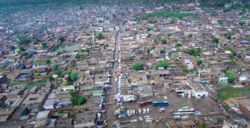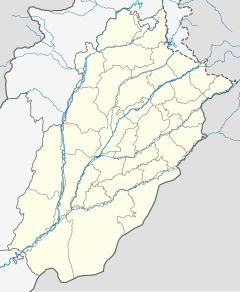
Nankana Sahib is a city and capital of Nankana Sahib District in the Punjab province of Pakistan. It is named after the first Guru of the Sikhs, Guru Nanak, who was born in the city and first began preaching here. Nankana Sahib is among the most important religious sites for the Sikh religion. It is located about 91 km (57 mi) west of Lahore and about 75 km (47 mi) east of Faisalabad. According to the census of 2017 the city has a population of 110,135 inhabitants. Until 2005, it was a part of the Sheikhupura District.

Sheikhupura also known as Qila Sheikhupura, is a city and district in the Pakistani province of Punjab. Founded by the Mughal Emperor Jahangir in 1607, Sheikhupura is the 16th largest city of Pakistan by population and is the headquarters of Sheikhupura District. The city is an industrial centre and satellite town, and is located about 38 km northwest of Lahore. It also borders Sialkot, Gujranwala, Nankana Sahib and Kasur districts of Punjab, Pakistan.

Sir Malik Khizar Hayat TiwanaKCSI, OBE was a British Indian statesman, landowner, army officer, and politician belonging to the Punjab Unionist Party. He served as the prime minister of the Punjab Province of British India between 1942 and 1947. He opposed the Partition of India and the ideology of Muslim League. He was eventually ousted from office by the Muslim League through a civil disobedience campaign, plunging Punjab into communal violence that led to the partition of the province between India and Pakistan.
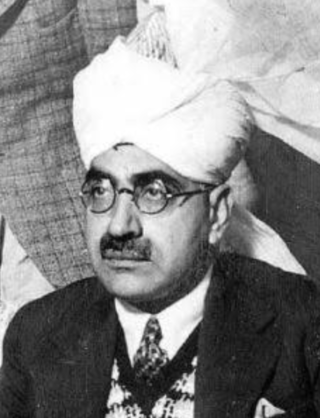
Khan Bahadur Major Sir Sikandar Hayat Khan,, also written Sikandar Hyat-Khan or Sikandar Hyat Khan, was an Indian politician and statesman from the Punjab who served as the Premier of the Punjab, among other positions.
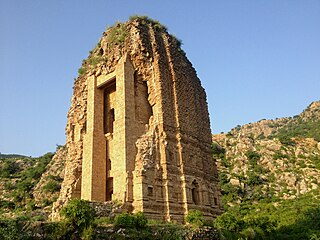
Khushab District, is a district in the province of Punjab, Pakistan, with its administrative capital in Jauharabad. The district is named after the historical city of Khushab.
The National Unionist Party was an Anti Brahmin movment or political party based in the Punjab Province during the period of British rule in India. The Unionist Party mainly represented the interests of the landed gentry and landlords of Punjab, which included Muslims, Hindus and Sikhs. The Unionists dominated the political scene in Punjab from World War I to the independence of India and the creation Pakistan after the partition of the province in 1947. The party's leaders served as Prime Minister of the Punjab. The creed of the Unionist Party emphasized: "Dominion Status and a United Democratic federal constitution for India as a whole".

Majha is a region located in the central parts of the historical Punjab region, currently split between the republics of Pakistan and India. It extends north from the right banks of the river Beas, and reaches as far north as the river Jhelum. People of the Majha region are given the demonym "Mājhī" or "Majhail". Most inhabitants of the region speak the Majhi dialect, which is the basis of the standard register of the Punjabi language. The most populous city in the area is Lahore on the Pakistani side, and Amritsar on the Indian side of the border.

Major Shaukat Hayat Khan was an influential politician, military officer, and Pakistan Movement activist who played a major role in the organising of the Muslim League in the British-controlled Punjab.
Nowshera, also Naushera, is a city and Tehsil in Khushab District, located in the Punjab Province of Pakistan.
Shahpur District, established in 1893 during the British Raj, existed in what is now Pakistan until 1960. From its inception until 1914, Shahpur served as the district headquarters. In 1914, the headquarters were relocated to Sargodha, although the district retained the name Shahpur. In 1960, the Sargodha District was formed, and Shahpur District was restructured as Shahpur Tehsil.
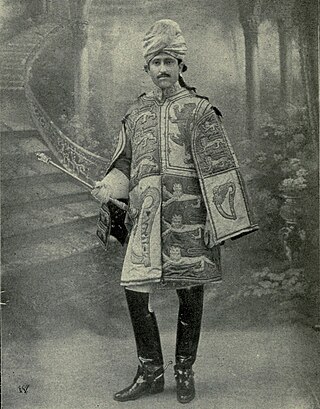
Major General Nawab Sir Umar Hayat Khan Tiwana, was a soldier of the Indian Empire, one of the largest landholders in the Punjab, and an elected member of the Council of State of India.
Shahpur Tehsil is a subdivision (tehsil) of Sargodha District in the Punjab province of Pakistan. Its capital is Shahpur and is administratively subdivided into 16 Union Councils. Population is 353,325 (2017) being mainly Muslim and Punjabi speaking.The name Shahpur is associated with one of grandfather of Sherazi Syed’s. The Qureshi family, Maken family and Tiwana family are the biggest landlords of this region.
Khan Sahib, Qazi Zafar Hussain came from a qadi's family which had, since the 16th century, been prominent among the landed aristocracy of the Soon Valley. He belonged to Awans tribe of ancient repute. He was awarded the title of Khan Sahib by the British Crown. This was a formal title, a compound of khan (leader) and sahib (Lord), which was conferred in Mughal Empire and British India. Although his father, Qazi Mian Muhammad Amjad forbade his descendants to establish Dargah, he was considered Sajjada Nashin by the people of his area. "Sajjada nashins" David Gilmartin asserts, "claimed to be the descendants of the Sufi, 'saints', intermediaries between the Faithful and their God, and this cut against the grain of Islamic orthodoxy ... in kind, of their special religious status, these sajjada nashins had become men of local standing in their own right." However he never claimed to be a Sajjada Nashin. In the Punjab, the sajjada nashin or pir families were not so rich in terms of land as the great land lords of Punjab but these sajjada nashin or pir families exerted great political and religious influence over the people. The British could not administer the area without their help and no political party could win the election without their help.

When the All-India Muslim League was founded at Dacca, on 30 December 1906 at the occasion of the annual All India Muhammadan Educational Conference, It was participated by the Muslim leaders from Punjab, i.e., Sir Mian Muhammad Shafi, Mian Fazl-i-Hussain, Abdul Aziz, Khawaja Yusuf Shah and Sh. Ghulam Sadiq. Earlier Mian Muhammad Shafi organised a Muslim Association in early 1906, but when the All-India Muslim League was formed, he established its powerful branch in the Punjab of which he became the general secretary. Shah Din was elected as its first president. This branch, organised in November 1907, was known as the Punjab Provincial Muslim League.
Qazi Mazhar Qayyum 'Raees-Azam Naushera', is a Pakistani politician. He came from a qadi's family that had been prominent among the landed aristocracy of the Soon Valley since the 16th century.
Umerpura Chak No.50 R/B ਟਿਵਾਨਾ, ٹوانہ Tiwana is a village in Shahkot tehsil, Nankana Sahib District, Punjab, Pakistan. It is 1.5 kilometres (0.9 mi) from Shahkot on the road to Sangla Hill. It has a primary school and a girls' middle school.

Nawab Muhammad Hayat Khan Khattar was a Punjabi Muslim Landlord who served the Government of British India and rose to considerable distinction.
Malik Sahib Khan TiwanaCSI was a Punjabi Muslim Jatt landowner during the British India.
The Tiwana family of Shahpur is a Punjabi Muslim feudal family part of the Tiwana Punjabi clan of Jats elite. The Tiwana family is one of the largest landowning families in the Punjab and its members have played an influential role in Punjabi politics since the 1600s.
